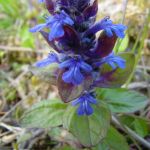| Common Name: |
Bugle |
| Botanical Name: |
Ajuga reptans |
| Genus: |
Ajuga |
| Family: |
Lamiaceae |
| Native Location: |
Europe, NW Africa, Turkey, Iran, and the Caucasus |
| Cultivation: |
Ajuga chamaepitys thrives in poor dry soil in full sun. Ajuga reptans and it cultivars may also be divided at any time if kept moist. Cultivars of A reptan do not come true from seed. |
| Propagation: |
By seed sown in autumn or spring. Germination may be erratic. Ajuga reptans and its cultivars may also be divided at any time if kept moist. Cultivars of A. reptans do not come from from seed. |
| Harvest: |
Leaves (A chamaepitys) are gathered in summer and dried for infusions and liquid extracts. Plants (A. reptans) are cut in summer; usually used fresh, in ointments or medicated oils. |
| Height: |
10-30cm (4-12in) |
| Width: |
Indefinite |
| Variations: |
Atropurpurea (bronze bugle)
Dark, purple-brown leaves.
Burgundy Glow
Silver-green leaves, variegated and suffused with shades of pink.
Catlin's Giant
Large bronze leaves to 15cm (6in) long, and flower spikes to 20cm (8in) long.
Multicolor syn. Rainbow
bronze leaves, variegated cream and pink.
Pink Elf
compact, with deep pink flowers on spikes up to 5cm (2in) high
Variegata
has light green leaves, irregularly variegated gray-green and cream. It has dense habit and is less vigourous than the species. |
| Hardiness: |
Z3-9 |
| Parts Used: |
Whole plant. |
| Properties: |
A mild, painkilling and astringent herb with a slight laxative effect. |
| Medicinal Uses: |
Externally for bruises, wounds, and tumors. |
| Bibliography: |
Encyclopedia of Herbs by Deni Brown Copyright © 1995, 2001 Dorling Kindersley Limited Pp 108 |
